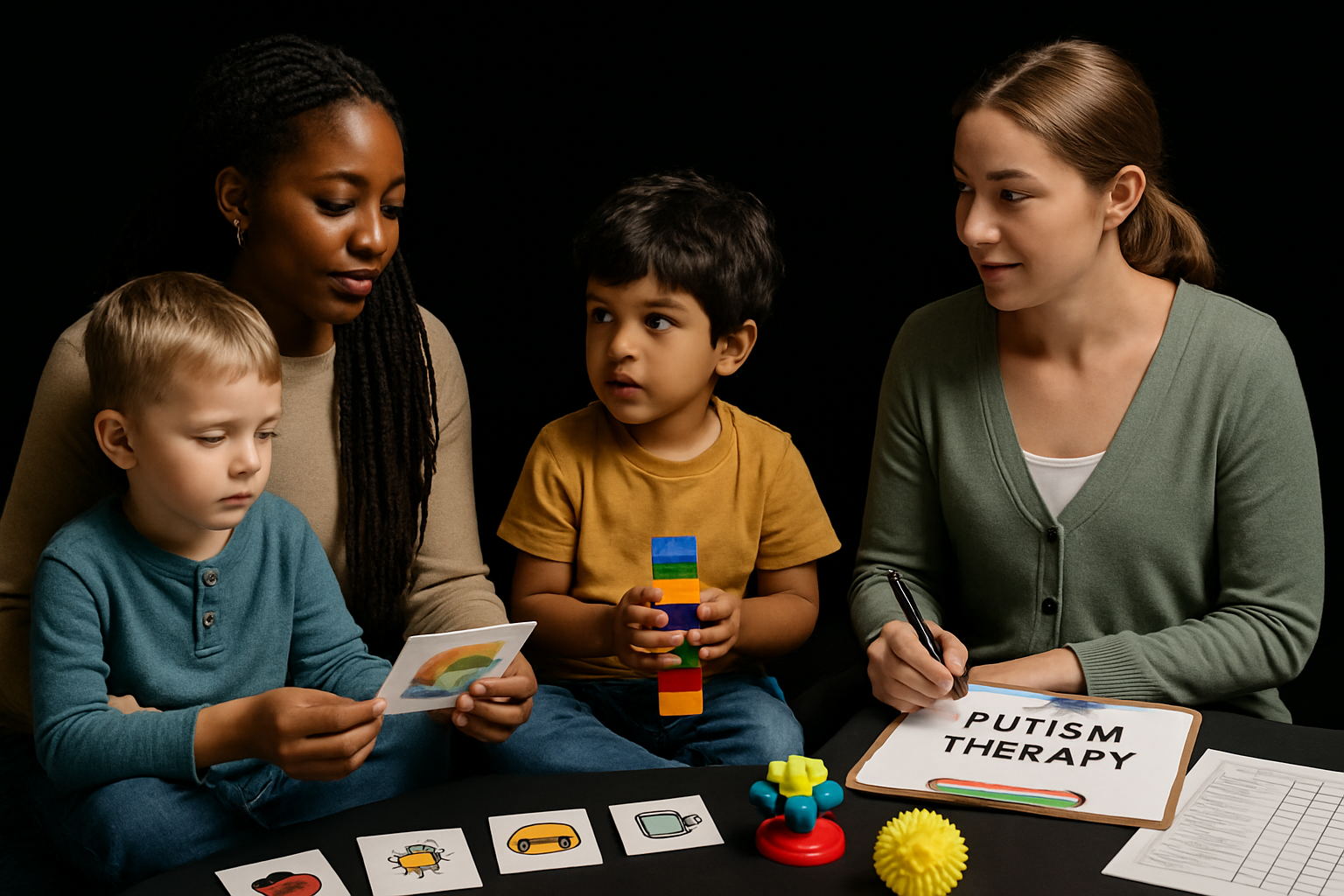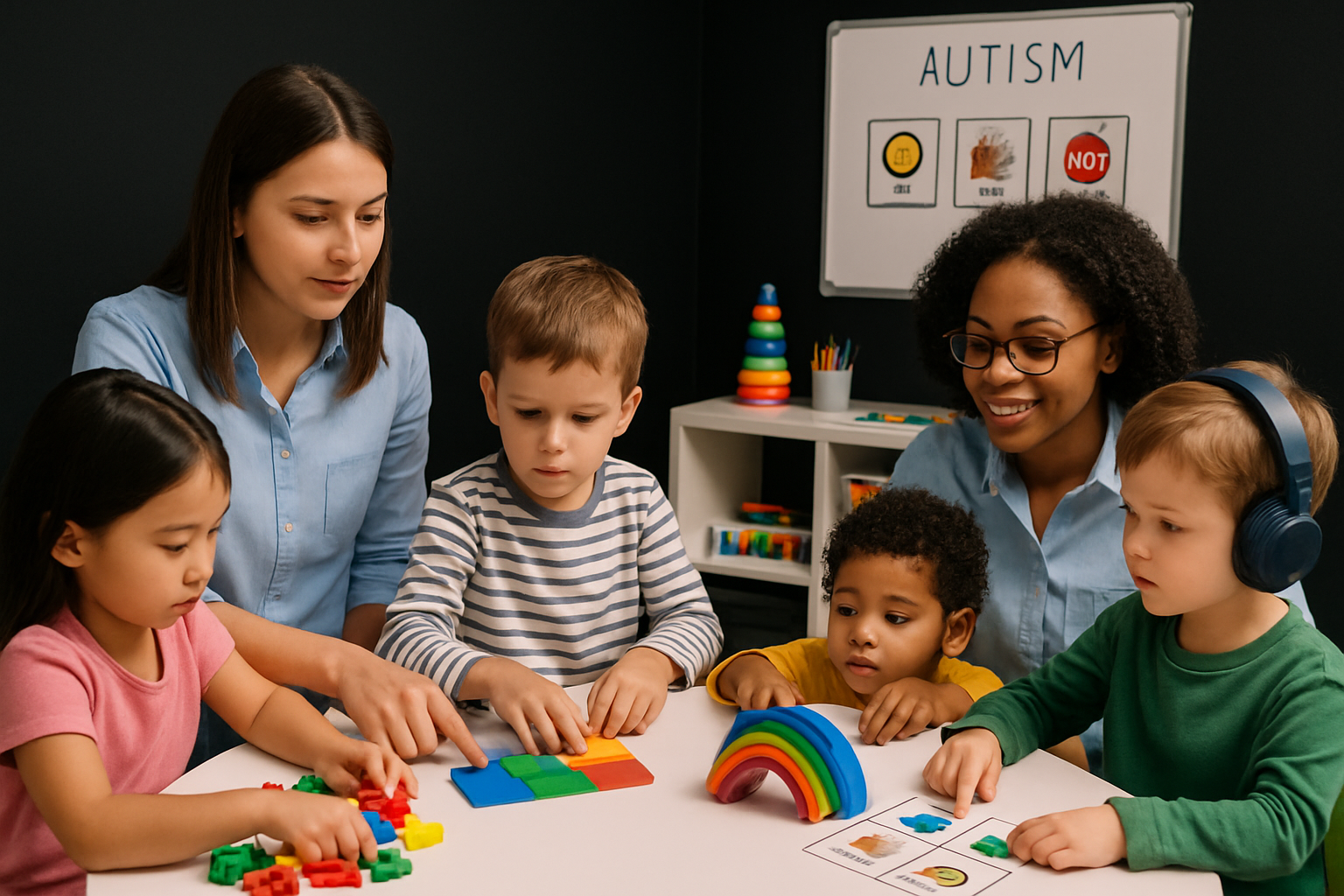Autism is more visible than ever, and families are searching for answers as the demand for behavioral interventions for autism increases in 2025. If you’re a parent or caregiver seeking strategies that truly make a difference, you’re not alone. The world of autism support is rapidly evolving, with new research and science-backed methods driving better outcomes.
This comprehensive guide brings clarity to evidence-based approaches, outlining practical steps and key considerations for both families and professionals. Inside, you’ll find an overview of intervention models, focused strategies, ways to involve parents, the importance of professional support, and the latest advancements shaping the future of autism care.'
UNDERSTANDING BEHAVIORAL INTERVENTIONS FOR AUTISM
Understanding behavioral interventions for autism is crucial for families and professionals navigating the evolving landscape of autism care. These interventions are grounded in principles like Applied Behavior Analysis (ABA), operant conditioning, and classical conditioning. Early intervention is often emphasized, as it can lead to optimal outcomes for children on the spectrum. Behavioral interventions for autism are designed to address core symptoms—such as communication and social interaction challenges—and associated difficulties like repetitive behaviors. Evidence consistently supports behavioral interventions for autism as a first-line treatment, with improvements noted in cognitive function, language development, social engagement, and adaptive behaviors. Leading organizations, including the CDC, APA, and AACAP, recognize these interventions as essential. It's important to distinguish behavioral approaches from developmental and educational interventions, as each has unique principles and methods.

DEFINING BEHAVIORAL INTERVENTIONS AND THEIR ROLE IN AUTISM
Behavioral interventions for autism are structured approaches based on learning theory, where desired behaviors are reinforced, and challenging behaviors are addressed through systematic strategies. Core methods include ABA, which uses operant and classical conditioning to teach new skills and reduce problematic actions. Early intervention is vital, as research shows children benefit most when support begins before age three. These interventions target a range of symptoms, from communication deficits to social challenges. Substantial evidence highlights gains in cognitive abilities, language, and daily living skills. Esteemed organizations like the CDC and APA endorse behavioral interventions for autism as foundational, setting them apart from purely developmental or educational strategies.
TYPES OF BEHAVIORAL INTERVENTIONS: COMPREHENSIVE VS. FOCUSED
Behavioral interventions for autism can be grouped into comprehensive treatment models and focused interventions. Comprehensive models, such as Early Intensive Behavioral Intervention (EIBI) and Naturalistic Developmental Behavioral Interventions (NDBIs), address multiple developmental domains over extended periods—often 25 to 40 hours per week. In contrast, focused interventions target specific skills or behaviors, like social communication or daily living tasks, and are typically shorter in duration. For example, EIBI provides structured, intensive teaching, while focused programs might address one social skill at a time. Comprehensive models suit children needing broad support, while focused approaches are effective for addressing particular challenges.
| Intervention Type | Scope | Duration | Target Population |
| Comprehensive | Multiple domains | 25-40+ hrs/week | Young children needing broad support |
| Focused | Specific skills | Variable | Children/adults with targeted needs |
Evidence Base and Effectiveness: What the Research Shows
Research consistently demonstrates the effectiveness of behavioral interventions for autism. Meta-analyses report medium to large effect sizes for EIBI, with improvements in language ($g=0.50–0.57$), social skills ($g=0.42$), and self-help abilities ($g=0.55$). Early intervention, especially before age three, is linked to better outcomes. Naturalistic models like NDBIs also show positive effects, though more high-quality studies are needed. Limitations in research include small sample sizes and variable study designs, making it essential to interpret findings carefully. For a deeper dive into recent scientific evidence and practical outcomes, see this comprehensive review of behavioral interventions for autism spectrum disorder.
CHALLENGES AND CONSIDERATIONS IN BEHAVIORAL INTERVENTIONS
Despite their benefits, behavioral interventions for autism face several challenges. Access is limited by a shortage of trained professionals, high costs, and regional availability. Cultural and individual differences can impact how children respond to interventions. It's crucial to tailor each plan to the child's unique strengths and needs. Family involvement and consistent adherence to protocols drive success. Emerging trends include integrating technology and telehealth to broaden reach and enhance flexibility for families. These innovations offer hope for reducing barriers and making effective support more accessible.
THE ROLE OF QUALIFIED PROFESSIONALS IN INTERVENTION DELIVERY
Delivering behavioral interventions for autism requires expertise and proper certification, such as Board Certified Behavior Analysts (BCBA). Collaboration among therapists, educators, and families ensures that interventions are both effective and ethical. Maintaining fidelity to treatment protocols and upholding professional standards are essential for achieving positive outcomes. Working as a multidisciplinary team maximizes the benefits of intervention and supports the child's holistic development.
COMPREHENSIVE TREATMENT MODELS FOR AUTISM
Comprehensive treatment models serve as the backbone of behavioral interventions for autism, offering structured, evidence-based approaches designed to address a wide range of developmental needs. These models are rooted in decades of research, evolving to meet the diverse challenges faced by individuals with autism and their families. Let's explore the leading comprehensive models, their unique features, and how they contribute to meaningful, lasting change.

Early Intensive Behavioral Intervention
Early Intensive Behavioral Intervention (EIBI) is a cornerstone of behavioral interventions for autism, targeting children as young as two years old. EIBI typically involves 25 to 40 or more hours per week of one-on-one therapy over a duration of 12 to 24 months. Sessions are highly structured, relying on Discrete Trial Training (DTT) and individualized skill-building plans.
EIBI focuses on improving core areas such as IQ, adaptive behaviors, language, and daily living skills. Research consistently demonstrates medium to large effect sizes across these domains, especially when intervention begins before age three. For instance, studies report gains in cognitive function, socialization, and self-help skills after sustained EIBI.
Several factors influence EIBI success, including treatment intensity, family involvement, and consistency in implementing strategies. Despite its strengths, EIBI does have limitations. Not all children experience the same level of symptom reduction, and long-term outcomes can vary.
For families seeking an in-depth look at how these comprehensive models are structured and delivered, the Comprehensive Behavior Solutions for Autism article offers further insights into the practical application of these methods.
Naturalistic Developmental Behavioral Interventions (NDBIs)
Naturalistic Developmental Behavioral Interventions (NDBIs) blend behavioral science with developmental psychology, making them a flexible option within behavioral interventions for autism. NDBIs are delivered in natural settings, such as the home or preschool, and focus on social skills, communication, and learning through play and daily routines. [Image illustrating a Naturalistic Developmental Behavioral Intervention scenario, showing a child and therapist playing together on the floor while interacting naturally]
Examples of NDBIs include the Early Start Denver Model (ESDM), JASPER, and Pivotal Response Treatment. These models emphasize child-led interactions, shared activities, and active caregiver participation. Research highlights moderate effect sizes, with studies showing improvements in language, imitation, and social engagement.
NDBIs are especially well-suited for young children, offering a less rigid structure than traditional EIBI. While promising, NDBIs face challenges related to the need for more high-quality research and ensuring broad accessibility. Still, they remain a vital part of behavioral interventions for autism, empowering families to embed learning opportunities into everyday life.
COMPARISON TABLE: EIBI VS. NDBIS
| Feature | EIBI | NDBIs |
| Setting | Structured, clinic/home | Natural, home/community |
| Intensity | 25-40+ hrs/week | Flexible, often fewer hours |
| Approach | Therapist-led, DTT | Child-led, play-based |
| Parent Involvement | Supportive | Essential |
| Age Focus | < 5 years | < 5 years |
The Early Start Denver Model (ESDM)
The Early Start Denver Model (ESDM) stands out as a play-based, relationship-focused intervention for toddlers and preschoolers. ESDM is delivered by trained therapists and parents, seamlessly integrated into daily routines and activities.
As a comprehensive approach within behavioral interventions for autism, ESDM targets cognitive function, language, and adaptive behaviors. Meta-analyses reveal significant gains after 3 to 12 months, with children showing marked improvements in communication and daily living skills.
ESDM is accessible for families willing to undergo specialized training, though implementation can be challenging due to intensive resource requirements. Despite these hurdles, ESDM remains a leading model, particularly for very young children needing early, holistic support.
Other Comprehensive Models: JASPER, Early Social Interaction, and More
Beyond EIBI and ESDM, several other comprehensive models are integral to behavioral interventions for autism. JASPER, for example, focuses on joint attention, symbolic play, and engagement, making it highly effective for developing social skills in preschoolers.
The Early Social Interaction program emphasizes parent-mediated, naturalistic strategies to foster communication and social interaction. Research supports the effectiveness of these approaches, showing significant gains in play, language, and social engagement.
However, access to these models can vary by region, and some programs may require specialized provider training. Families often need to explore local resources and consult professionals to determine which comprehensive model is most appropriate for their child's unique profile.
The Importance of Individualization in Comprehensive Models
No two individuals with autism are exactly alike, which is why individualization is crucial in behavioral interventions for autism. Comprehensive models must begin with a thorough assessment, ensuring intervention plans are tailored to each child's strengths and needs. Balancing structured teaching with naturalistic, flexible approaches helps maximize engagement and learning. Collaboration between families and professionals is essential, fostering a team-based atmosphere where progress is regularly monitored and adjustments are made as needed.
By prioritizing individualization, comprehensive treatment models ensure that every child receives the most effective, responsive support possible, setting the stage for lifelong growth and development.
FOCUSED BEHAVIORAL INTERVENTIONS: TARGETING KEY SKILLS AND BEHAVIORS
Supporting individuals with autism often means targeting specific skills and behaviors that can make daily life smoother and more fulfilling. Focused interventions are highly individualized, zeroing in on particular areas like social skills, communication, self-care, and emotional regulation. With ongoing research and new techniques, behavioral interventions for autism continue to evolve, offering families and professionals concrete tools and hope for meaningful progress.

Social Skills Training (SST)
Social Skills Training (SST) is a cornerstone of behavioral interventions for autism, designed to help children and young adults master key social abilities. These skills include making eye contact, greeting others, having conversations, sharing, and understanding emotions. SST can be delivered one-on-one, in small groups, through peer-mediated models, or even within school settings.
Research shows that SST leads to measurable gains. Meta-analyses report medium to large effect sizes, meaning many participants see real-world improvements. SST is effective across a wide age range, from toddlers to young adults, with programs tailored to developmental stages. For younger children, models like JASPER focus on play-based learning and joint engagement.
Barriers do exist, such as accessing trained facilitators and ensuring that skills generalize outside of therapy. For more actionable tips and activities, you can explore Nurturing Social Skills in ASD, which provides practical insights grounded in the latest behavioral interventions for autism.
Social Communication Interventions: AAC and PECS
Communication challenges are a hallmark of autism, making interventions like Augmentative and Alternative Communication (AAC) and the Picture Exchange Communication System (PECS) essential. AAC includes tools such as visual cues, sign language, and speech-generating devices, all supporting expressive and receptive language.
PECS is a structured approach rooted in behavioral interventions for autism, guiding individuals through stages of exchanging pictures for desired items or actions. This system uses ABA principles to teach requesting, commenting, and answering questions.
Studies show AAC and PECS can improve the frequency and clarity of communication, especially for children ages 0–14. Effect sizes tend to be small to medium for speech development, but the impact on independence can be significant. Challenges remain, such as encouraging spontaneous speech and ensuring ongoing assessment to track progress.
Addressing Combined Symptoms: Sleep, Feeding, and Toileting
Many families face daily hurdles related to sleep, feeding, or toileting. Focused behavioral interventions for autism are effective at tackling these specific issues. For sleep, strategies include consistent bedtime routines, visual schedules, and positive reinforcement for staying in bed.
Feeding interventions may involve gradual exposure to new foods, using rewards for trying bites, and desensitization techniques to reduce aversions. Toilet training often follows a stepwise behavioral protocol, with scheduled bathroom visits and reinforcement for successes.
Research supports that these focused approaches can decrease challenging behaviors and boost independence. Consistency and family involvement are key, as is collaboration with professionals trained in behavioral interventions for autism.
Emotional and Behavioral Regulation: CBT and Related Approaches
Emotional and behavioral regulation is a vital aspect of well-being for many individuals with autism. Cognitive Behavioral Therapy (CBT) has been adapted as part of behavioral interventions for autism to address anxiety, anger, and emotional challenges. These adaptations often include visual supports, clear language, and active parent participation.
CBT and similar approaches are supported by research showing improvements in emotional self-control and reduced problem behaviors. However, access can be limited by a shortage of specialized providers. Integrating CBT with other behavioral interventions for autism creates a holistic plan, addressing both emotional and practical needs.
Parent-Mediated Interventions (PMI)
Parent-Mediated Interventions (PMI) empower families to take an active role in their child's development. Through training and coaching, parents learn to use behavioral interventions for autism at home and in the community. This hands-on approach helps children generalize new skills beyond the therapy setting.
Benefits of PMI include improved child functioning, reduced parental stress, and stronger family bonds. Evidence shows that when parents are equipped with effective strategies, children are more likely to make lasting gains. Barriers may include limited access to high-quality training and the need for ongoing support, but the impact of family involvement remains a cornerstone of successful behavioral interventions for autism.
IMPLEMENTING BEHAVIORAL INTERVENTIONS: PRACTICAL STEPS FOR FAMILIES AND PROFESSIONALS
Embarking on the journey of behavioral interventions for autism can feel overwhelming. However, breaking the process into clear, manageable steps helps families and professionals create effective, individualized plans that truly support the person’s growth.

Step 1: Assessment and Goal Setting
Getting started with behavioral interventions for autism begins with a thorough assessment. This step involves understanding the individual's strengths, challenges, and unique developmental profile.
Professionals and families work together to gather information through standardized assessments, interviews, and careful observation. Setting measurable, achievable goals ensures the intervention is meaningful and tailored to the family’s priorities.
Ongoing reassessment is crucial, as needs and abilities evolve. For families navigating this step, the Parent Guide After Autism Diagnosis offers helpful guidance on collaborating with professionals and advocating for your child.
Step 2: Selecting the Right Intervention Model
Choosing the best approach is essential for maximizing the benefits of behavioral interventions for autism. Comprehensive and focused models each offer unique advantages depending on age, developmental stage, and specific goals.
Families and professionals should weigh the evidence base, accessibility, and available resources. Consulting with qualified experts can help match the intervention to the individual’s profile. Realistic expectations and flexibility are key, as intervention needs may change over time.
Case examples and professional input can further clarify this decision, ensuring the chosen model aligns with the family's values and practical realities.
Step 3: Building a Multidisciplinary Team
Effective behavioral interventions for autism rely on a collaborative, multidisciplinary team. This often includes behavior analysts, therapists, educators, and, most importantly, family members.
Clear communication and shared decision-making foster trust and keep everyone aligned. Regular team meetings help review progress, troubleshoot challenges, and celebrate achievements.
By integrating medical, educational, and behavioral support, the team ensures a holistic approach to intervention. Empowering families as active participants creates a supportive environment for lasting growth.
Step 4: Implementing the Intervention Plan
With the plan in place, it’s time to put behavioral interventions for autism into action. Sessions are structured around the individual’s needs—considering frequency, setting, and duration.
Strategies such as reinforcement, prompting, and data collection help maintain engagement and track progress. Generalizing skills across home, school, and community settings is a top priority.
Learning more about the foundational principles behind these strategies is valuable—explore the Basics of Applied Behavior Analysis for practical insights on session structure and best practices.
Step 5: Monitoring Progress and Making Data-Driven Adjustments
Continuous monitoring ensures behavioral interventions for autism remain effective and responsive. Data is collected on specific skills and behaviors, allowing teams to analyze trends and make timely adjustments.
Celebrating milestones keeps motivation high, while setbacks are addressed promptly. Families play a central role in tracking progress and providing feedback.
Transition planning is also vital—preparing for less intensive supports as skills develop. Regular review and adaptation guarantee that the intervention continues to meet the individual’s evolving needs.
ADVANCES AND FUTURE DIRECTIONS IN BEHAVIORAL INTERVENTIONS FOR AUTISM (2025)
The landscape of behavioral interventions for autism is rapidly evolving as we approach 2025. Families and professionals now have access to emerging approaches, advanced technologies, and a deeper understanding of what drives positive outcomes. Staying informed about these advances ensures that individuals with autism receive the most effective, personalized care possible.
Integration of Technology and Digital Tools
Technology is transforming behavioral interventions for autism. Telehealth platforms now allow therapists to deliver remote assessments, parent training, and direct intervention, making services more accessible for families in rural or underserved areas.
Digital tools are also revolutionizing data collection and progress monitoring. Apps and online platforms help track goals, analyze trends, and adjust strategies in real time. Excitingly, virtual reality and gamified apps are being used to teach social and communication skills in immersive, engaging ways.
Artificial Intelligence (AI) is a groundbreaking addition to this field, improving both diagnosis and intervention. For a deeper dive into the latest AI advancements, see AI in Autism Diagnosis and Intervention. As these technologies become more refined, they promise to further enhance behavioral interventions for autism by delivering tailored, effective solutions.
Personalized and Precision Interventions
Personalization is at the forefront of behavioral interventions for autism. Recent research is exploring how genetics, neurobiology, and individual behavioral profiles can inform more precise treatment plans. By leveraging AI and machine learning, clinicians can predict which strategies may work best for each person.
The concept of precision therapy is gaining ground, with ongoing studies seeking to identify biomarkers that indicate likely intervention outcomes. This allows for earlier, more effective support tailored to each individual’s strengths and needs.
Ethical considerations are crucial, especially as technology and data use expand. Balancing innovation with privacy and informed consent will shape the future of behavioral interventions for autism, ensuring progress benefits all.
Expanding Access and Reducing Disparities
Access to high-quality behavioral interventions for autism remains a challenge for many families. Efforts are underway to address shortages of trained professionals, particularly in rural, low-income, or minority communities.
Policy changes and expanded insurance coverage are making it possible for more children to receive evidence-based interventions. Multicultural and linguistically responsive approaches are also being prioritized, helping interventions resonate with diverse families.
Community-based programs, outreach initiatives, and telehealth are further bridging the gap, making behavioral interventions for autism more equitable and widely available.
Collaboration Between Research and Practice
Closing the gap between research findings and daily practice is a top priority for the next generation of behavioral interventions for autism. Implementation science is helping effective models reach more clinics, schools, and homes.
Training programs for both professionals and families are expanding, ensuring interventions are delivered with fidelity. Importantly, the voices of families and individuals with autism are increasingly included in the development and evaluation of new approaches.
This collaborative spirit is driving innovation, ensuring behavioral interventions for autism remain evidence-based, practical, and person-centered.
Addressing Gaps and Controversies
Despite advances, important questions remain about behavioral interventions for autism. Debates continue about the ideal intensity, duration, and combination of approaches for different age groups and profiles.
Critiques of current models highlight the need for more randomized controlled trials and longer-term studies. There is also a growing movement toward balancing behavioral strategies with developmental and educational perspectives, aiming for care that is both effective and respectful of individual differences.
Calls for holistic, person-centered care are shaping the next wave of research and practice, ensuring the evolution of behavioral interventions for autism is guided by both science and compassion.
PREPARING FOR THE NEXT DECADE IN AUTISM INTERVENTION
Looking forward, the future of behavioral interventions for autism will be defined by innovation, integration, and inclusivity. Advances in genetics, technology, and community engagement are expected to converge, creating new opportunities for personalized, accessible support.
Individualized, evidence-based care will remain the gold standard, with a continued focus on empowering families and individuals to thrive.
If you’re feeling inspired to take the next step after learning about the latest behavioral interventions for autism, you’re not alone—we know how important it is to find support that truly fits your family. At Silveira Behavior Consultants, we’re here to help you navigate these options with personalized ABA therapy and a team that genuinely cares about your goals. Whether you’re curious about clinic-based sessions, in-home therapy, or parent training, we’ll work together to create a plan that’s right for you. Ready to learn more? Inquire About Services and let’s start this journey together.





